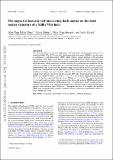| dc.contributor.author | Chua, Kun Ting Eddie | |
| dc.contributor.author | Dibert, Karia | |
| dc.contributor.author | Vogelsberger, Mark | |
| dc.contributor.author | Zavala, Jesús | |
| dc.date.accessioned | 2022-05-06T16:53:06Z | |
| dc.date.available | 2022-05-06T16:53:06Z | |
| dc.date.issued | 2020 | |
| dc.identifier.uri | https://hdl.handle.net/1721.1/142400 | |
| dc.description.abstract | We study the effects of inelastic dark matter (DM) self-interactions on the internal structure of a simulated Milky Way (MW)-size halo. Self-interacting dark matter (SIDM) is an alternative to collisionless cold dark matter (CDM) which offers a unique solution to the problems encountered with CDM on sub-galactic scales. Although previous SIDM simulations have mainly considered elastic collisions, theoretical considerations motivate the existence of multistate DM where transitions from the excited to the ground state are exothermic. In this work, we consider a self-interacting, two-state DM model with inelastic collisions, implemented in the arepo code. We find that energy injection from inelastic self-interactions reduces the central density of the MW halo in a shorter time-scale relative to the elastic scale, resulting in a larger core size. Inelastic collisions also isotropize the orbits, resulting in an overall lower velocity anisotropy for the inelastic MW halo. In the inner halo, the inelastic SIDM case (minor-To-major axial ratio s c/a ≈ 0.65) is more spherical than the CDM (s ≈ 0.4), but less spherical than the elastic SIDM case (s ≈ 0.75). The speed distribution f(v) of DM particles at the location of the Sun in the inelastic SIDM model shows a significant departure from the CDM model, with f(v) falling more steeply at high speeds. In addition, the velocity kicks imparted during inelastic collisions produce unbound high-speed particles with velocities up to 500 km s-1 throughout the halo. This implies that inelastic SIDM can potentially leave distinct signatures in direct detection experiments, relative to elastic SIDM and CDM. | en_US |
| dc.language.iso | en | |
| dc.publisher | Oxford University Press (OUP) | en_US |
| dc.relation.isversionof | 10.1093/MNRAS/STAA3315 | en_US |
| dc.rights | Attribution-NonCommercial-ShareAlike 4.0 International | en_US |
| dc.rights.uri | https://creativecommons.org/licenses/by-nc-sa/4.0/ | en_US |
| dc.source | arXiv | en_US |
| dc.title | The impact of inelastic self-interacting dark matter on the dark matter structure of a Milky Way halo | en_US |
| dc.type | Article | en_US |
| dc.identifier.citation | Chua, Kun Ting Eddie, Dibert, Karia, Vogelsberger, Mark and Zavala, Jesús. 2020. "The impact of inelastic self-interacting dark matter on the dark matter structure of a Milky Way halo." Monthly Notices of the Royal Astronomical Society, 500 (1). | |
| dc.contributor.department | Massachusetts Institute of Technology. Department of Physics | |
| dc.relation.journal | Monthly Notices of the Royal Astronomical Society | en_US |
| dc.eprint.version | Author's final manuscript | en_US |
| dc.type.uri | http://purl.org/eprint/type/JournalArticle | en_US |
| eprint.status | http://purl.org/eprint/status/PeerReviewed | en_US |
| dc.date.updated | 2022-05-06T16:40:28Z | |
| dspace.orderedauthors | Chua, KTE; Dibert, K; Vogelsberger, M; Zavala, J | en_US |
| dspace.date.submission | 2022-05-06T16:40:30Z | |
| mit.journal.volume | 500 | en_US |
| mit.journal.issue | 1 | en_US |
| mit.license | OPEN_ACCESS_POLICY | |
| mit.metadata.status | Authority Work and Publication Information Needed | en_US |
